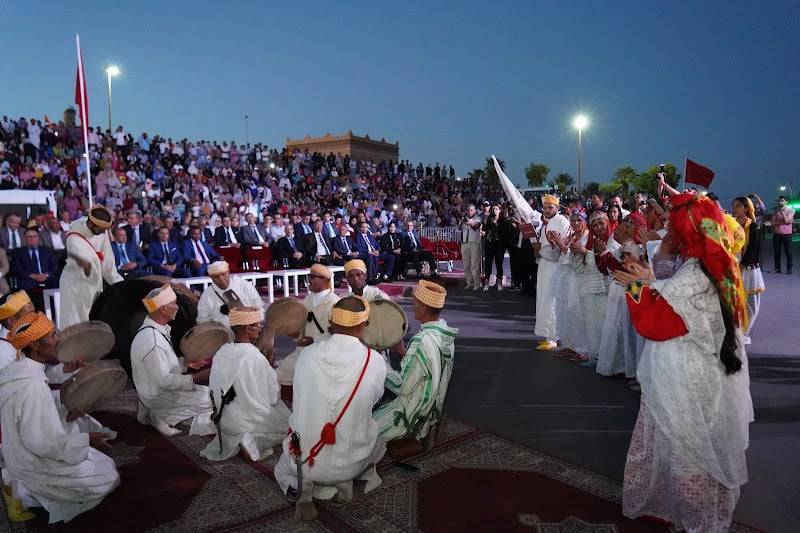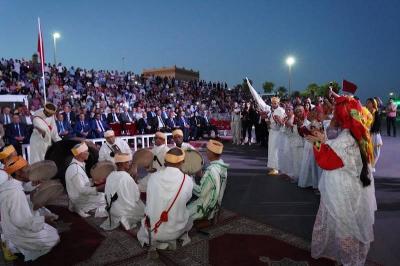Gradually, the amateur feminine practice of Ahouach art in several areas of the Souss-Massa region is fading, making way for professional practice through groups that offer paid entertainment services during annual seasons and cultural events, whether local or national. While the villages of the region used to be bustling with artistic activities involving women performing Ahouach dances at this time of year, the current reality is different, with a noticeable decline in amateur female participation facing uncertainty, while the male practice of this art retains its momentum and benefits from marketing through social media.
Many knowledgeable in this subject argue that technological development has significantly contributed to the current situation of female practice in this art. It has become clear that women are reluctant to document their celebrations, reflecting a conservative mindset, leading to an increase in professional male practice while women's participation grows, albeit at a lower rate. They consider that "the period before the advent of social media saw a revival of spontaneous female practice of this ritual, before we entered a phase of decline and modesty."
Ibrahim Al-Mazand, a cultural actor in the Souss-Massa region and artistic director of the Timitar Festival, stated that "the decline in non-professional female practice of Ahouach art is a noticeable reality, despite this traditional performance being able to keep pace with modernity and open up to professionalism, especially among men who have established professional groups and a market for paid entertainment." Al-Mazand added that "technology has impacted the decline in women's practice of Ahouach from an amateur perspective; even if it is seasonal rather than permanent, it has been observed that the level of activity in this regard has significantly decreased in mountainous areas in recent years, alongside the technological boom and complete openness of Moroccans to new technology and digital communication."
The speaker elaborated on the situation: "We mention this reality while recalling that women are apprehensive of cameras and phones, and anything that could broadcast their activities from the village to the community and make it accessible to social media users." He believes that "the elements of dignity and caution still govern this matter; manifested in the lack of desire to appear digitally or document any part in which women participate at a time when technology could support both male and female professional activities."
The cultural actor considered that Ahouach art, although it appears to continue currently, loses part of itself each year, particularly from a human perspective, as it has become clear that we are losing valuable human resources and a generation of professionals without having a new generation that is knowledgeable in the operational aspects of this traditional performance, especially since this art form is not taught in national institutes but is acquired solely through practice."
Abdel Wahid Al-Asri, a researcher in the cultural field, shared similar analytical views, noting that "the time before smartphones was marked by a revival of amateur female practice of Ahouach art in the Souss-Massa region, before we saw its intensity decline over the last decade following the emergence and development of technological means." Al-Asri told Hespress that "in contrast, we have witnessed an increase in women’s interest in establishing their professional groups through which they offer their entertainment services for a fee, as they oversee the entertainment of parties and weddings in various regions and also participate in local festivals, naturally wearing the traditional headscarf known as 'Adal'."
He pointed out that "male groups have also developed recently, leading to strong competition among them for securing a larger share of requests for entertaining at seasonal parties and artistic events." Connecting to the topic of the decline in amateur female practice of this art form, the director of the Anarouz Festival in Tafarout noted that "the rise of modern photography and digital documentation techniques, including phones and social media, remains a key factor contributing to the unknown fate of amateur female practice in this art, particularly considering that the areas concerned with these performances still have a significant presence of conservative mentality that cannot accept adopting new trends that deviate from the norm."
Finally, Al-Asri pointed out that "there are other critical factors in this regard, including increased migration and the lack of enthusiasm among the new generation of young women to participate in this performance in front of a crowd primarily made up of local villagers or an influx of audiences from outside."




